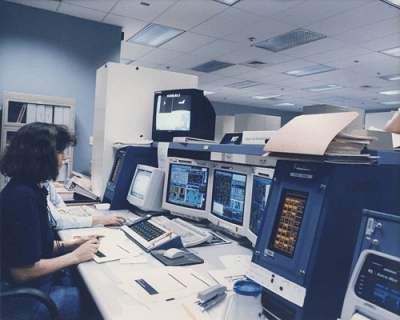 I am watching three computer screens at once, one showing the Space Shuttle’s location in orbit, the other two filled with data displays. It’s 1997 and I am a flight controller working at Mission Control at NASA-Johnson Space Center (NASA-JSC) in Houston, Texas as a Data Communications Officer. It’s my job to manage the onboard data recorders on the Space Shuttle.
I am watching three computer screens at once, one showing the Space Shuttle’s location in orbit, the other two filled with data displays. It’s 1997 and I am a flight controller working at Mission Control at NASA-Johnson Space Center (NASA-JSC) in Houston, Texas as a Data Communications Officer. It’s my job to manage the onboard data recorders on the Space Shuttle. As I watch the progress of the recorders on my display, one stops recording. I send a command to the Space Shuttle to turn it back on. It doesn’t respond. I turn the other recorder on, but that recorder is nearly full.
On my headset, I hear chatter as I monitor multiple audio loops to stay abreast of what is happening in systems that may affect mine. I select the audio loop to contact the Instrumentation and Communications Officer (INCO) – the flight controller I report to – and I alert him that the recorder has stopped and my attempt to turn it back on has failed.
I can feel my heart rate accelerate. What should I do? Stay calm. Follow your procedure. You know what to do. INCO asks me for my recommendation. I tell him that, when available, we need the crew to follow the onboard procedures for a recorder restart. I listen as INCO contacts the Flight Director, who authorizes the message to be sent via the Capsule Communicator (CAPCOM) – an astronaut working in Mission Control and the only individual on the ground that all shuttle communications go through. CAPCOM calls the shuttle. The astronauts receive the message and I anxiously wait to see if my recorder will come back online.
So what happened?
Fortunately, this was just a simulation. Actually, things didn’t go wrong that often during the Space Shuttle missions I worked, and when they did, we knew what to do, because of all of our training.
My experience at NASA-JSC started in the fall of 1993. As a Computer-Electrical Engineering student at Purdue University, I was selected to participate in NASA’s co-op program, an opportunity for me to work every other semester at NASA while I was in college. After graduating, I went to work for them full-time.
Being at NASA was an amazing experience. I was working next to brilliant people who were committed to excellence and had a high attention to detail.
Today, I still work with a team of brilliant people, only now we focus on B2B eCommerce projects. There are many things that I have gleaned from my experience at NASA that apply to the work we do today.
Practice. Practice. Practice.
One way we do this is to perform what we call a “Mock Go Live” for new site launches. When we do a Mock Go Live, we pretend we are taking the site live. We run through our processes with the most recent set of data and test the site with other systems, to ensure we know how everything will work.
We typically discover something that needs to be tweaked. The key is identifying – through practice – how we make the real Go Live as efficient and uneventful as possible.
No Single Point of Failure
Similarly, in the world of eCommerce, it is important to think about where a single failure could bring down your site or interrupt your user’s experience. A few areas we commonly create redundancy is within hosting environments and for data integrations.
There is a need to understand the cost and likelihood of the risk compared to the cost of maintaining a redundant system. Some risks may be acceptable for your business, while others may not be.
Processes Minimize Mistakes
Astronauts trained for every possible scenario in environments that were as true to life as possible including cockpit simulators, flight simulators, zero-gravity plane flights on a KC-135A, and the Weightless Environment Training Facility (WETF), which allowed astronauts to practice spacewalks.
When astronauts or flight controllers were training for their job, it was key to have checklists and procedures that they could follow to ensure that, in a potentially stressful situation, they knew exactly what they needed to do.
In the same way, we need to look for processes that can be repeated in our B2B eCommerce world, document those processes, train for them and refine them over time. Having a process enables us to have discussions about how we might improve it and to tweak it over time. Then each of our customers benefits from the collective experience of our team.
Houston, We’ve Got a Problem
“We have customers calling and reporting that they are unable to check out but we can’t recreate the problem here. We know it’s working for some of our customers but not others.”“Our eCommerce site is sporadically going down. It just started a week ago and no one has made any changes.”
These are examples of some of the requests for help we receive. To assist these clients, we end up playing the role of a data detective. Solving problems like these can be tricky. You have to have a good knowledge of the system as a whole to figure out what is happening.
While at NASA, I also worked as an Instrumentation Officer (INST). In that role, I needed to have an understanding of how the data sensors on board the Shuttle were related at a system level. For example, could a circuit failure be causing a set of sensors to be reporting low values? If so, people might misinterpret the data and be working the wrong problem.
In the same way, we need to be on the lookout for problems that aren’t what they might appear to be at first glance. Sometimes problems appear to be one thing, when in fact they are something completely different.
Go For Launch
Training, preparing for what might go wrong, and practicing major events teaches you that you can overcome difficult situations. You gain confidence in yourself and in your team. When it comes to the real thing, you feel good because you know you are prepared. You worked through the stuff that was difficult and overcame it. You have a team around you who have done the same.Be sure your own development team is set up to ensure your B2B eCommerce site offers an experience that is out of this world!



